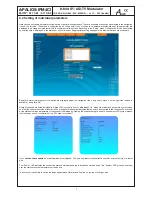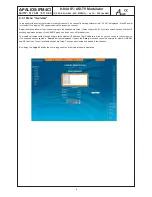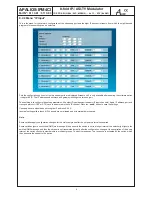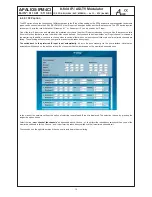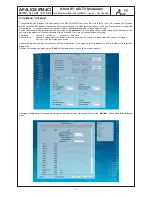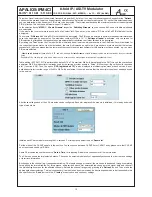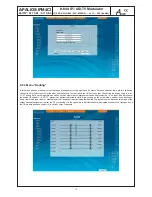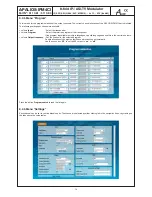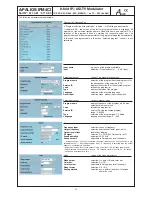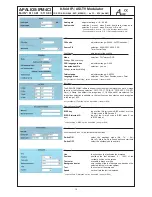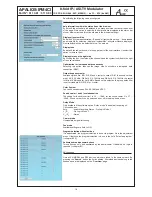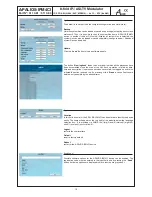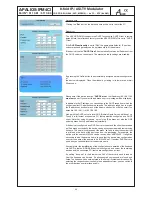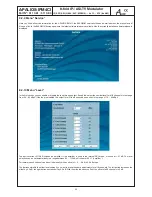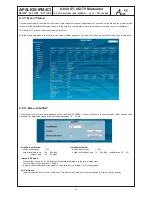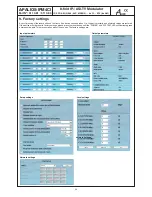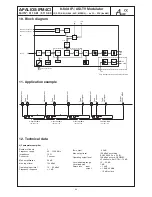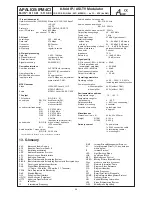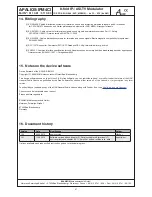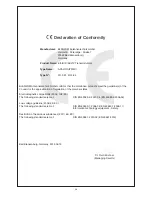
21
8-fold IP-/ ASI-TV Modulator
IP/ SFP/ ASI (H.264/ AVC, MPEG2)
→
4x CI
→
ATV (8x AM)
A-PALIOS-IPM4CI
Part N
o
: 5113.81 / 5113.83
SNMP option
First section: The “
Mode
“ selection field enables or disables the SNMP functionality,
including the sending of traps. The selector “
Version
“ sets the SNMP version
(version 1, 2 or 3). In the two fields below, the reading and writing via SNMP is
separately indicated for the versions 1 and 2.
In version 3, these two fields are disabled. Here, all registered users of the device
(GUI Settings
→
Passwords) have the automatic read access to SNMP. The write
access can be enabled or disabled for each user by clicking the SNMP-check box
in the “
Passwords
“ menu.
By clicking the “
MIB
“ button the MIB of the device is generated and can be
downloaded.
Second section: The trap settings are done here. First select the trap version:
V1 trap
normal traps according to SNMPv1 with specified community
V2 trap
normal traps according to SNMPv2 with specified community
V2 inform
sends information traps according to SNMPv2 and waits for an
acknowledgement
V3 trap
normal traps according to SNMPv3
V3 inform
sends information traps according to SNMPv3 and waits for an
acknowledgement
In traps of version 1 and 2 the community can be configured. In traps of version 3
you can configure the user/password and the usage of the network MAC address
as engine ID.
These settings must correspond with the configuration of the trap receiver, so
that traps are successfully transferred. For this purpose a test trap can be sent
by clicking the button “
Test
“. If a test trap triggered, all pre-preserved traps are
discarded.
Up to 256 IP addresses can be created resp. unlocked to receive the traps.These
are listed under “Receiver IP“.
Third section: events are configured, whether they (and with which thresholds)
trigger traps. There are three ways to
configure a trap
:
• without parameters, e.g. fan on/ off
• with a free selectable parameter for a medium priority
• with a selectable parameter from a list box for a medium priority
Events
Events leading up to trigger an SNMP trap, can be (de-) activated and their
parameters can be configured.
References and notes:
All users using SNMPv3 must use passwords with at least 8 characters. For SNMPv3 the A-LINE-SBLsupports only the authentication
password, not the privacy password. The A-LINE SBL only supports the MD5 algorithm for authentication password in SNMPv3.
Information traps are specific traps that are available since SNMPv2.If the sender gets no „acknowledge“ from the receiver, it will
retransmit until the „acknowledge“ is received.
An A-LINE SBL device keeps up to 256 information traps that were not sent successfully. If there are more unconfirmed traps, the older
traps are discarded and marked in the logbook as „failed“. A successfully sent trap is also registered in the logbook. In case of power
failure or reboot of the device the non-confirmed traps are lost.
You‘ll find details in the help text for each event. The critical priorities are set to fixed values that can not be changed.
If the web interface of A-PALIOS-IPM4CI device is open, no changes are possible via SNMP.
Passwords
This setting will only appear when you are logged in as administrator, who has the
permission to make administrative changes.
In addition the check box “
GUI settings
→
User and password check
“ has to be
enabled. The user ID and password for the administrator can be set in the first line.
Up to 8 users and passwords can be created. non-admin users have read-only
rights.
The default
password
for the
admin
is:
1111
and for
users
:
0000
If the SNMP option is enabled, for each user a SNMP check box will be displayed.
By clicking the box you assign the writing rights for individual users, available since
SNMP version 3 (
»
section SNMP option).

